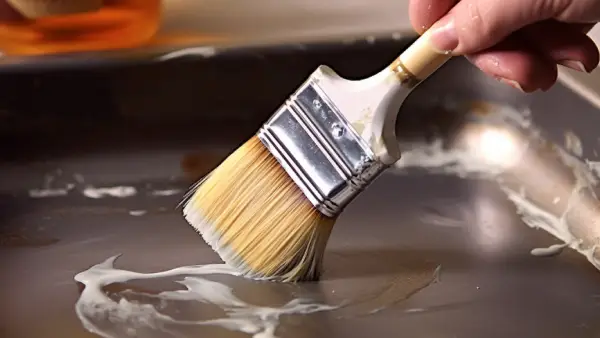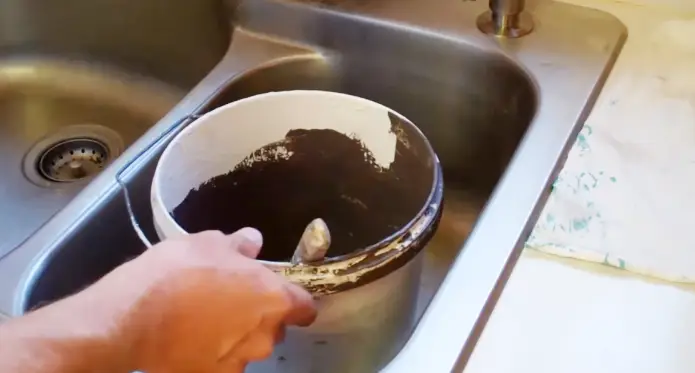Last Updated on November 14, 2023
Painting brushes need to be cleaned properly to last, minimize environmental impact, and prevent plumbing issues. You might be tempted to wash them in the kitchen sink and move on, but hold on a second. Can you really wash latex paint brushes in the kitchen sink to get a perfect, streak-free cleaning?
Paint brushes for water-based latex paint can be cleaned in the sink with a small amount of paint, but oil-based or enamel paint brushes should not. Washing these brushes in the sink can lead to plumbing nightmares and environmental hazards.
Throughout this article, we will discuss washing water-based latex paint brushes in the kitchen sink. We also explain why you shouldn’t wash non-water-based latex paint brushes in the sink and how to clean them safely.
How Can You Wash Latex Paint Brushes in the Sink: Follow the Steps

Latex paint brushes with a small amount of paint can be washed in the kitchen sink if there is no oil, enamel, or other water-resistant paint on them. To clean them properly, follow these steps:
- Step 1: Prepare the sink
- Step 2: Rinse the brush
- Step 3: Apply dish soap
- Step 4: Brush comb or wire brush
- Step 5: Rinse thoroughly
- Step 6: Dry the brush
- Step 7: Store or reuse
Step 1: Prepare the Sink
Gather all the necessary materials and place them next to the sink, such as the latex paint brushes, a container for water, and mild dish soap. Make sure the sink is clean and free of any debris.
Also, remove as much excess paint from the brush as possible. To remove solid paint residue, scrape the brush against a piece of cardboard.
Step 2: Rinse the Brush
Use your fingers to work the brush’s bristles under the running water, ensuring that any remaining paint particles are removed. Warm water through the bristles effectively flushes out any leftover paint, preventing it from drying and the sink drain clogging.
You can feel the paint breaking up and washing away as you work the bristles with your fingers. Continue this process until the water runs clear and no more visible paint is coming off the brush.
Step 3: Apply Dish Soap
Once you have rinsed the brush, applying dish soap to the bristles is important to ensure a thorough cleaning. Let it rest for 2 minutes. The dish soap helps break down any remaining water-based latex paint residue clinging to the bristles.
Step 4: Brush Comb or Wire Brush
Now, run the comb or wire brush through the bristles to remove any remaining paint residue. The comb or wire brush will help loosen any dried or stubborn paint that may still be clinging to the bristles. Repeat this process until you feel the bristles are free from paint residue.
Step 5: Rinse Thoroughly
Hold the brush under running water again after working the soapy water through the bristles. Keep rinsing the brush until no traces of soap or latex paint are left. Removing all the residues prevents any leftover paint from drying and hardening the bristles.
Step 6: Dry the Brush
Then, gently shake the brush to remove excess water and use a paper towel or cloth to blot the bristles and remove any remaining moisture.
Excess moisture can lead to mold or mildew growth on the bristles, which can ruin the brush and affect the quality of your next paint job. By blotting the bristles with a paper towel or cloth, you absorb any remaining water and speed up the drying process.
Also, don’t forget to reshape the bristles with your fingers to their original form.
Step 7: Store or Reuse
Now that your brush is clean and dry, you can store it or reuse it. To store, wrap the bristles in a cloth or plastic to protect them from dust, dirt, and debris.
Ensure it’s kept away from moisture until its next use. Hanging the brush upside down during storage to prevent the bristles from becoming misshapen.
Reasons to Avoid Washing Non-water-Based Paint Brushes in the Sink
For several reasons, you should avoid washing non-water-based latex paint brushes in the kitchen sink.
Reason 01: Risk of Plumbing Damage
In the kitchen sink, oil-based paints or latex paint brushes that are not water-based pose a serious threat to plumbing. Over time, the chemicals and components in these paints can solidify in your plumbing, causing clogs, blockages, and pipe damage.
Repairing or replacing plumbing due to paint-related issues can be expensive and inconvenient.
Reason 02: Septic System Problems
Washing non-water-based paint brushes in your kitchen sink can cause serious septic system problems. When you wash paint brushes in the sink, the paint residues can enter your septic tank and disrupt its natural biological processes.
This disruption can lead to system malfunctions, unpleasant odors, and expensive repairs. The paint residues can clog the pipes and filters in the septic system, reducing its efficiency and potentially causing backups and overflows.
Reason 03: Environmental Concerns
Many paints, particularly oil-based ones, contain hazardous chemicals and solvents that can harm the environment.
These harmful substances can enter rivers, lakes, and groundwater when you wash paint brushes in your kitchen sink. Such pollution can have detrimental effects on aquatic ecosystems and pose risks to human health.
Reason 04: Ineffective Cleaning of Sink Surfaces and Brushes
It’s okay to clean water-based latex paint in the sink, but other paints, like oil-based and enamel, can leave behind residues that are difficult to remove.
Also, when you try to clean these brushes in the sink with only fresh water, you often end up with brushes that still have paint residue on them. This can make them less effective for future use, as the paint residue can mix with new paint and create an uneven application.
How do I wash non-water-based latex paint brushes?

Consider using a bucket or kiddie pool to clean non-water-based latex paint brushes. Then, pour enough solvent into a small container and swirl the brush around. You can also use a brush comb or toothbrush to help remove any stubborn paint particles.
After cleaning the brush, rinse it with water into a bucket or kiddie pool to remove any remaining solvent. Dry the brush with a lint-free cloth and hang it up for storage.
Why is it crucial to clean paintbrushes immediately after use?
Cleaning paint brushes right away is essential because if you leave them with paint on them, they will dry and become harder to remove later.
The longer the paint sits on the bristles, the more time it has to harden, making cleaning more challenging. This can result in a buildup of dried paint, which not only affects the performance of the brush but also shortens its lifespan.
Promptly cleaning your paint brushes ensures they’re ready for your next painting project and helps maintain their quality and longevity.
Properly Clean Your Water-Based Latex Paint Brushes
Avoid washing a non-water-based latex paint brush in the kitchen sink next time. Instead, opt for the proper method of cleaning non-water-based latex paint brushes discussed above to ensure their longevity and effectiveness.
Taking the time to clean your brushes immediately after use will not only save you money on replacements but will also ensure the quality of your artwork. A clean paintbrush is like a well-tuned instrument, ready to create beautiful masterpieces with every stroke.

